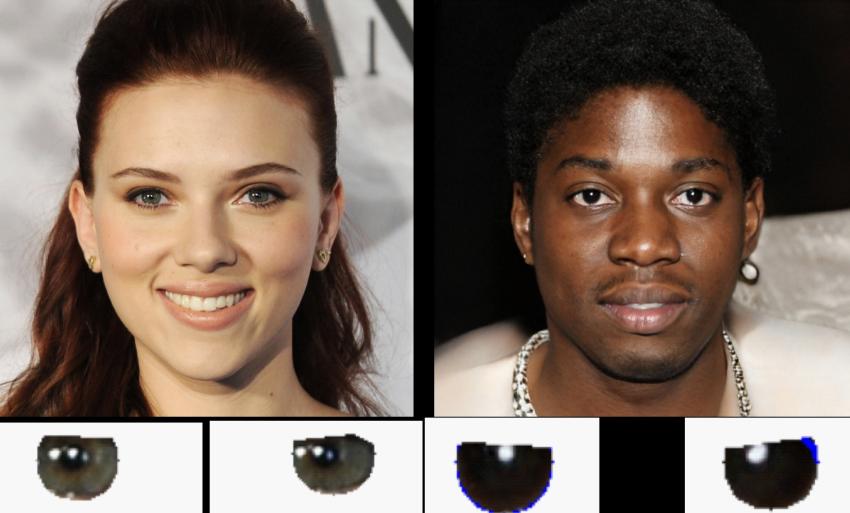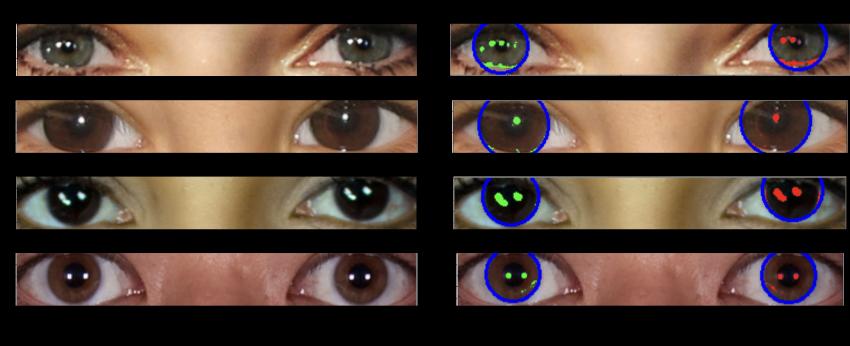In an era when the creation of artificial intelligence (AI) images is at the fingertips of the masses, the ability to detect fake pictures – particularly deepfakes of people – is becoming increasingly important.
So what if you could tell just by looking into someone's eyes?
That's the compelling finding of new research shared at the Royal Astronomical Society’s National Astronomy Meeting in Hull, which suggests that AI-generated fakes can be spotted by analysing human eyes in the same way that astronomers study pictures of galaxies.
The crux of the work, by University of Hull MSc student Adejumoke Owolabi, is all about the reflection in a person's eyeballs.
If the reflections match, the image is likely to be that of a real human. If they don't, they're probably deepfakes.
"The reflections in the eyeballs are consistent for the real person, but incorrect (from a physics point of view) for the fake person," said Kevin Pimbblet, professor of astrophysics and director of the Centre of Excellence for Data Science, Artificial Intelligence and Modelling at the University of Hull.
Researchers analysed reflections of light on the eyeballs of people in real and AI-generated images. They then employed methods typically used in astronomy to quantify the reflections and checked for consistency between left and right eyeball reflections.
Fake images often lack consistency in the reflections between each eye, whereas real images generally show the same reflections in both eyes.
"To measure the shapes of galaxies, we analyse whether they're centrally compact, whether they're symmetric, and how smooth they are. We analyse the light distribution," said Professor Pimbblet.
"We detect the reflections in an automated way and run their morphological features through the CAS [concentration, asymmetry, smoothness] and Gini indices to compare similarity between left and right eyeballs.
"The findings show that deepfakes have some differences between the pair."
The Gini coefficient is normally used to measure how the light in an image of a galaxy is distributed among its pixels. This measurement is made by ordering the pixels that make up the image of a galaxy in ascending order by flux and then comparing the result to what would be expected from a perfectly even flux distribution.
A Gini value of 0 is a galaxy in which the light is evenly distributed across all of the image's pixels, while a Gini value of 1 is a galaxy with all light concentrated in a single pixel.
The team also tested CAS parameters, a tool originally developed by astronomers to measure the light distribution of galaxies to determine their morphology, but found it was not a successful predictor of fake eyes.
"It's important to note that this is not a silver bullet for detecting fake images," Professor Pimbblet added.
"There are false positives and false negatives; it's not going to get everything. But this method provides us with a basis, a plan of attack, in the arms race to detect deepfakes."
Media contacts
Sam Tonkin
Royal Astronomical Society
+44 (0)7802 877 700
Dr Robert Massey
Royal Astronomical Society
Mob: +44 (0)7802 877 699
Megan Eaves
Royal Astronomical Society
Science contacts
Kevin Pimbblet
University of Hull
Images and captions
Caption: In this image, the person on the left is real, while the person on the right is AI-generated. Their eyeballs are depicted underneath their faces. The reflections in the eyeballs are consistent for the real person, but incorrect (from a physics point of view) for the fake person.
Credit: Adejumoke Owolabi
Caption: A series of deepfake eyes showing inconsistent reflections in each eye.
Credit: Adejumoke Owolabi
Caption: A series of real eyes showing largely consistent reflections in both eyes.
Credit: Adejumoke Owolabi
Notes for editors
The NAM 2024 conference is principally sponsored by the Royal Astronomical Society, the Science and Technology Facilities Council and the University of Hull.
About the Royal Astronomical Society
The Royal Astronomical Society (RAS), founded in 1820, encourages and promotes the study of astronomy, solar-system science, geophysics and closely related branches of science.
The RAS organises scientific meetings, publishes international research and review journals, recognises outstanding achievements by the award of medals and prizes, maintains an extensive library, supports education through grants and outreach activities and represents UK astronomy nationally and internationally. Its more than 4,000 members (Fellows), a third based overseas, include scientific researchers in universities, observatories and laboratories as well as historians of astronomy and others.
The RAS accepts papers for its journals based on the principle of peer review, in which fellow experts on the editorial boards accept the paper as worth considering. The Society issues press releases based on a similar principle, but the organisations and scientists concerned have overall responsibility for their content.
Keep up with the RAS on X, Facebook, LinkedIn and YouTube.
About the Science and Technology Facilities Council
The Science and Technology Facilities Council (STFC) is part of UK Research and Innovation – the UK body which works in partnership with universities, research organisations, businesses, charities, and government to create the best possible environment for research and innovation to flourish.
STFC funds and supports research in particle and nuclear physics, astronomy, gravitational research and astrophysics, and space science and also operates a network of five national laboratories, including the Rutherford Appleton Laboratory and the Daresbury Laboratory, as well as supporting UK research at a number of international research facilities including CERN, FERMILAB, the ESO telescopes in Chile and many more.
STFC's Astronomy and Space Science programme provides support for a wide range of facilities, research groups and individuals in order to investigate some of the highest priority questions in astrophysics, cosmology and solar system science.
STFC's astronomy and space science programme is delivered through grant funding for research activities, and also through support of technical activities at STFC's UK Astronomy Technology Centre and RAL Space at the Rutherford Appleton Laboratory. STFC also supports UK astronomy through the international European Southern Observatory and the Square Kilometre Array Organisation.
Visit https://stfc.ukri.org/ for more information. Follow STFC on Twitter: @STFC_Matters
About the University of Hull’s E.A. Milne Centre
The E.A. Milne Centre for Astrophysics at the University of Hull brings together experts who study the evolution of structure in the Universe ranging from stars through to galaxies and galaxy clusters, right up to the largest structures in the cosmos.
The centre employs observations, theory and computational methods in collaboration with international partners. Postgraduate and undergraduate students work alongside staff to understand the wonders of the Universe. Through a series of outreach activities, the centre also aims to share its passion for astronomy and astrophysics with the region and beyond.




